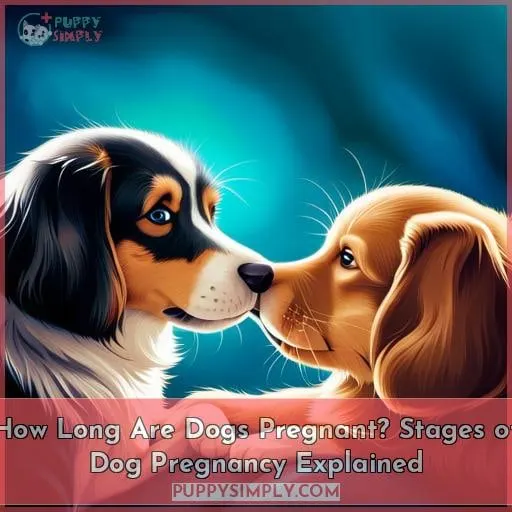This site is supported by our readers. We may earn a commission, at no cost to you, if you purchase through links.
 Uncertain about the physical changes your canine companion is going through? Knowing how long dogs are pregnant and what to expect during each stage of gestation can help you prepare for this special time.
Uncertain about the physical changes your canine companion is going through? Knowing how long dogs are pregnant and what to expect during each stage of gestation can help you prepare for this special time.
Dog pregnancy lasts an average of 63 days, with labor lasting anywhere from 8 to 24 hours depending on breed and litter size. During this period, there will be a number of noticeable signs that indicate your pup is expecting.
Table Of Contents
- Key Takeaways
- The Reproductive Cycle in Dogs
- How to Tell if a Dog is Pregnant
- Gestation Period: How Long Are Dogs Pregnant?
- Stages of Dog Pregnancy
- How Long Are Dogs in Labor?
- Taking the Next Step
- What Should I Do During Pregnancy?
- How Can I Be Sure My Dog is Pregnant?
- Frequently Asked Questions (FAQs)
- Conclusion
Key Takeaways
- Dog pregnancy lasts an average of 63 days.
- Dogs go through stages during their reproductive cycle: proestrus, estrus, diestrus, anestrus, and gestation.
- Veterinary care is important during each stage.
- Proper nutrition and regular checkups are crucial for a successful pregnancy.
The Reproductive Cycle in Dogs
You should be aware of the reproductive cycle in dogs and understand its importance to ensure your pet has a healthy pregnancy and delivery. Dogs go through several stages during their reproductive cycle, including proestrus, estrus (heat), diestrus, anestrous (period between heats), and gestation.
Veterinary care is important throughout each stage for monitoring signs that are normal or abnormal in order to provide appropriate medical treatment if necessary. Breed differences can affect the length of time spent at any given stage as well as what constitutes normal levels of estrogen during certain times in the cycle.
Dietary needs may also change depending on which phase your pup is currently going through; additional calcium will often be recommended while pregnant or nursing puppies.
The heat period usually lasts around 3 weeks with a few days before this where you’ll begin seeing signs like increased urination and aggression towards males – these are known as pro-oestrus symptoms that signify when it’s time for breeding opportunities! After mating takes place, vaginal smears can help determine how far along she is into her gestation period – generally lasting about 63 days but varying by breed type – so owners should monitor closely until all placentas have been delivered safely before deeming labor complete.
How to Tell if a Dog is Pregnant
To determine if your pet is pregnant, look for signs of proestrus such as increased urination and aggression towards males. Monitor vaginal smears to track progress in the gestation period. Observe when all placentas have been delivered.
To detect a pregnancy accurately, it is important to be aware of the distinct stages that constitute her reproductive cycle. This includes pro-oestrus, estrus (heat), diestrus, anestrous (period between heats), and finally reaching full-term gestation.
Monitoring symptoms like intra-abdominal pressure can also help you identify when labor has begun. Although blood tests are available, they may not always provide accurate results due to timing or other factors.
Once puppies start coming out, pay close attention so that any potential complications during delivery can be addressed quickly by a vet. The best time for the birth of a reserved puppy usually lasts about 63 days but varies according to breed type! Postpartum care is essential after labor ends.
This includes proper feeding regimes and making sure both the mother dog and newborns receive adequate nutrition and hydration levels daily for healthy growth and development.
Gestation Period: How Long Are Dogs Pregnant?
The average canine gestation period is typically 63 days, and it’s important to recognize the distinct stages of a dog’s reproductive cycle in order to accurately detect pregnancy. Eating habits should be monitored during this time, as well as their exercise routine and vaccinations.
Breeder’s litter size estimation may also help determine how far along your pet is in her pregnancy journey.
As labor nears its end, pay close attention so any complications can be addressed quickly by your vet. Monitoring symptoms like intra-abdominal pressure or labor lasting more than 24 hours ensures timely interventions if necessary.
Stages of Dog Pregnancy
You’re halfway through your pet’s pregnancy journey! Month two is the time to monitor her temperature, as well as provide additional nutrition and exercise. During month three, you should be able to identify how many puppies she will be delivering soon.
It is important that all medical checkups are completed during this stage in order for both mother and litter to remain healthy throughout the process.
Month Two
During month two of your pet’s pregnancy, it’s important to monitor her eating habits and weight gain while ensuring she gets the necessary vaccinations.
Ultrasound scans can show fetal development, distinctive shape of the fetus’ skull, and size. Nesting behavior is also an indication that labor is approaching as hormones like relaxin increase in production.
Diet changes should be made at this point to ensure proper nutrition levels for both mom and baby-to-be, with closer monitoring on maternal hydration levels too! Keep track of these symptoms along with further research on AKC Gazette for more tips regarding a healthy pregnancy journey ahead – there’s still one last phase left before delivery day arrives!
Month Three
You’re nearing the end of the journey! During month three, your furry companion’s pregnancy will be reaching its conclusion as her body prepares for delivery. Nearly born puppies are producing more meconium, and placenta delivery is imminent.
It’s important to keep an eye out for labor complications such as a prolonged period or too much time between pups passing through the birth canal. Both can put mom and the litter at risk. Diet management should still remain high on your priority list, while routine checkups with a vet are necessary to ensure everything goes smoothly throughout this dog’s pregnancy.
For breeders, it’s also essential that intact female dogs have blood tests done before their first breeding season so any health issues could be avoided in future litters! An abdominal ultrasound during this stage can show fetal development, skull shape, size, and movement.
How Long Are Dogs in Labor?
Experience the thrilling, yet demanding process of canine labor: from the anticipation to delivery and beyond. Monitoring contractions, recognizing signs of imminent labor, preparing for what’s ahead, and recognizing complications are all key elements in ensuring a safe birth.
Visible contractions begin shortly before birthing begins; as time passes, abdominal pressure increases gradually until it reaches its peak during active stage one labor when puppies start being delivered.
Recognizing risks throughout each stage is essential too. If labor lasts more than 24 hours or there is more than 2 hours between puppy delivery, then serious complications may arise, which could put both the mother and unborn puppies’ lives at risk.
Proper nutrition throughout these stages will help ensure the proper development of young pups – food intake should be increased incrementally towards the end to meet energy demands associated with labor! With knowledge on hand, you can confidently navigate through these stages while providing your pet with everything she needs for a healthy start!
Taking the Next Step
Now that you understand the labor process and what to look out for, it’s time to take the next step: making sure your pet is properly nourished throughout their pregnancy.
The average canine gestation period is about 63 days, so it’s important to make sure they are receiving all of the nutrients necessary for a successful birth! Monitoring labor, preparing the diet, tracking progress, and recognizing signs are key elements in providing care during this stage.
An easy way to stay up-to-date on best practices related to planned breeding is through subscribing or reading the AKC Gazette – the official journal of purebred dog sport published since 1889. You can read current issues online or receive them via email, and there are also 10 years’ worth of back issues available.
What Should I Do During Pregnancy?
You may have heard that pregnant dogs are delicate and require special care. Making sure your pet has the right diet, routine, and medications during her pregnancy is essential for a healthy litter of puppies.
Feeding her properly balanced meals with high-quality proteins can help ensure she gets all the nutrients she needs throughout gestation. You should also establish a regular exercise schedule to keep up their energy levels while avoiding activities that could cause harm or discomfort to both mother and unborn pups.
Finally, it’s important to consult your veterinarian about any medications you might need as well as discuss any health concerns they might have during this time period!
Diet
Providing proper nutrition during the canine pregnancy is essential for a successful birth and healthy puppies. Feeding frequency should be increased as nutritional needs change throughout gestation, while maintaining a moderate calorie content in their diet.
Vitamin supplements may also need to be added, and specialized diets are available if needed.
The second half of the pregnancy requires even more attention to ensure the mother’s milk production will properly support her litter. High-quality foods rich in fatty acids, such as docosahexaenoic acid (DHA), can help with this process.
With care and diligence from you, your pet’s health – both during pregnancy and beyond – is well within reach!
Routine
To ensure a smooth pregnancy, you should keep your pup on an even routine of exercise and rest.
For best results, schedule regular checkups with the vet. Maintain a healthy diet with tips from experts. Have a medication list ready for labor signs like fetal swellings or abdominal radiograph. Provide nutritional supplements for high levels of omega 3s before the birth canal begins to dilate.
With the right attention given throughout each stage, you’ll be able to help your pup give birth safely and healthily!
Medications
As your pup progresses through the pregnancy, it’s important to provide them with any medications prescribed by their vet. Nutrition and exercise are essential for a healthy pregnancy. Ultrasounds help track hormone levels and number of fetuses while veterinary care monitors individual fetal swellings.
As labor approaches, vaginal discharges indicate an enlarged uterus as well as an increase in muscular wall of the uterus strength during contractions.
How Can I Be Sure My Dog is Pregnant?
Checking for signs of pregnancy is the best way to confirm if your dog is expecting. Monitoring her behavior and changes in body condition are key components in determining if she’s pregnant. Veterinary visits should be scheduled at regular intervals throughout gestation to ensure that both mom and puppies are healthy, as well as to address any nutritional needs or exercise guidelines specific to a pregnant dog.
It’s also important that you have an emergency plan prepared just in case something goes wrong during labor or delivery!
During the 18-to-21 days after mating, pay special attention to certain clues of pregnancy such as changes in appetite, tiredness, and enlargement of the mammary glands before taking a positive test from your vet.
With proper care throughout each stage, along with being aware of any potential risks associated with having a pregnant dog, it’ll help make sure everyone involved stays safe and happy come time for delivery day!
Frequently Asked Questions (FAQs)
What is the average size of a dog litter?
The average size of a dog litter is between four and six puppies. However, some breeds may have larger litters, while others may be smaller. With proper care and nutrition during pregnancy, you can ensure the health of both the mother and her pups.
What are the symptoms of labor in dogs?
Signs of labor in dogs include panting, restlessness, water breaking and nesting behavior. Contractions will start and puppies may be seen moving through the abdomen. Bearing down or straining could indicate delivery is near! Monitor closely for any signs of distress to ensure a safe birth process.
How can I tell if my dog is pregnant?
Observe your dog’s behavior for changes, such as appetite, activity level, and nesting. Have her checked by a vet to confirm pregnancy with an ultrasound or blood test. Monitor her weight gain and track the time until she goes into labor – usually 63 days from conception.
Are there any special dietary requirements for a pregnant dog?
Yes! Pregnant dogs need extra nutrients, such as calcium and protein. Feed her two small meals a day with high-quality food for optimal health. Avoid foods with fillers or by-products; fresh fruits and veggies are great snacks too! Keep her hydrated to ensure she’s getting the necessary vitamins and minerals for momma and puppies alike.
What should I do if I suspect my dog is having complications during labor?
If you suspect that your dog is experiencing complications during labor, it is crucial to seek immediate medical assistance. Keep a close eye on the duration of labor, and if there is a gap of more than two hours between puppies, take appropriate action.
Providing proper care and nutrition can help minimize the risk of complications, so it is advisable to consult with a veterinarian to ensure a safe pregnancy.
Conclusion
In conclusion, pregnancy in dogs is a complex and delicate process that requires patience and understanding. It is important to remain aware of the signs of puppy development and labor, and to be prepared to take the necessary steps if intervention is needed.
The AKC Gazette is a great source of information to help owners through the experience of dog pregnancy. Just like a growing plant, your puppy’s pregnancy requires the right conditions and care to ensure a healthy birth.
With the right amount of attention, your puppy will create a beautiful litter of healthy puppies.














